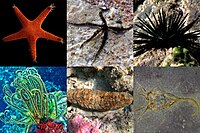
A wnt2 ortholog in the sea urchin Paracentrotus lividus
Sign Up to like & getrecommendations! Published in 2019 at "genesis"
DOI: 10.1002/dvg.23331
Abstract: Members of the wnt gene family encode secreted glycoproteins that mediate critical intercellular communications in metazoans. Large‐scale genome and transcriptome analyses have shown that this family is composed of 13 distinct subfamilies. These analyses have… read more here.
Keywords: sea; paracentrotus lividus; lividus; wnt genes ... See more keywords

Long-term maintenance of the sea urchin Paracentrotus lividus in culture
Sign Up to like & getrecommendations! Published in 2017 at "Aquaculture Reports"
DOI: 10.1016/j.aqrep.2017.04.003
Abstract: Abstract The common sea urchin Paracentrotus lividus (Lamarck, 1816) is an important commercial species in the Mediterranean Sea for the consumption of its gonads (roe). This species has also long been used as an animal… read more here.
Keywords: sea; long term; paracentrotus lividus; sea urchin ... See more keywords

Energy budget of cultured Paracentrotus lividus under different temperatures
Sign Up to like & getrecommendations! Published in 2019 at "Aquaculture"
DOI: 10.1016/j.aquaculture.2018.11.006
Abstract: Abstract Energy budget and resource distribution were evaluated for the sea urchin Paracentrotus lividus from the Eastern Mediterranean, reared in relatively low (20–22 °C) and high (24–26 °C) temperature regimes. Energy expenditure was quantified for the processes… read more here.
Keywords: paracentrotus lividus; water; temperature; energy budget ... See more keywords

Leachates of micronized plastic toys provoke embryotoxic effects upon sea urchin Paracentrotus lividus.
Sign Up to like & getrecommendations! Published in 2019 at "Environmental pollution"
DOI: 10.1016/j.envpol.2019.01.098
Abstract: Microplastics are defined as plastic fragments read more here.
Keywords: sea urchin; paracentrotus lividus; lividus; leachates micronized ... See more keywords

Ocean acidification modulates the incorporation of radio-labeled heavy metals in the larvae of the Mediterranean sea urchin Paracentrotus lividus.
Sign Up to like & getrecommendations! Published in 2018 at "Journal of environmental radioactivity"
DOI: 10.1016/j.jenvrad.2018.04.017
Abstract: The marine organisms which inhabit the coastline are exposed to a number of anthropogenic pressures that may interact. For instance, the accumulation of toxic metals present in coastal waters is expected to be modified by… read more here.
Keywords: paracentrotus lividus; sea urchin; ocean acidification;

Short-term variation of abundance of the purple sea urchin, Paracentrotus lividus (Lamarck, 1816), subject to harvesting in northern Portugal.
Sign Up to like & getrecommendations! Published in 2018 at "Marine environmental research"
DOI: 10.1016/j.marenvres.2018.09.017
Abstract: Paracentrotus lividus is a common and intensely harvested sea urchin at several European locations, including the Mediterranean Sea and the Atlantic coast of the Iberian Peninsula. The increasing human pressure on this resource due to… read more here.
Keywords: sea; period; abundance; paracentrotus lividus ... See more keywords

Sea urchin chronicles. The effect of oxygen super-saturation and marine polluted sediments from Bagnoli-Coroglio Bay on different life stages of the sea urchin Paracentrotus lividus.
Sign Up to like & getrecommendations! Published in 2020 at "Marine environmental research"
DOI: 10.1016/j.marenvres.2020.104967
Abstract: In marinas and harbours, the accumulation of pollutants in sediments, combined with poor exchange of water with the open sea, poses a major environmental threat. The presence of photosynthetic organisms and the related oxygen production,… read more here.
Keywords: sea; contaminated sediments; bagnoli coroglio; paracentrotus lividus ... See more keywords

Three-year monitoring of genetic diversity reveals a micro-connectivity pattern and local recruitment in the broadcast marine species Paracentrotus lividus
Sign Up to like & getrecommendations! Published in 2017 at "Heredity"
DOI: 10.1038/s41437-017-0013-6
Abstract: In conservation and management of marine biological resources, a knowledge of connectivity is necessary to understand how local populations are naturally replenished by the arrival of new recruits from source populations. At small geographical scales,… read more here.
Keywords: three year; paracentrotus lividus; connectivity; local recruitment ... See more keywords

Presence and biodistribution of perfluorooctanoic acid (PFOA) in Paracentrotus lividus highlight its potential application for environmental biomonitoring
Sign Up to like & getrecommendations! Published in 2021 at "Scientific Reports"
DOI: 10.1038/s41598-021-98284-2
Abstract: The first determination of presence and biodistribution of PFOA in ninety specimens of sea urchin Paracentrotus lividus from two differently contaminated sites along Palermo’s coastline (Sicily) is reported. Analyses were performed on the sea urchins’… read more here.
Keywords: pfoa; potential application; paracentrotus lividus; lividus ... See more keywords

Amino-modified polystyrene nanoparticles affect signalling pathways of the sea urchin (Paracentrotus lividus) embryos
Sign Up to like & getrecommendations! Published in 2017 at "Nanotoxicology"
DOI: 10.1080/17435390.2017.1279360
Abstract: Abstract Polystyrene nanoparticles have been shown to pose serious risk to marine organisms including sea urchin embryos based on their surface properties and consequently behaviour in natural sea water. The aim of this study is… read more here.
Keywords: embryos; sea; paracentrotus lividus; sea urchin ... See more keywords

Ovothiol ensures the correct developmental programme of the sea urchin Paracentrotus lividus embryo
Sign Up to like & getrecommendations! Published in 2022 at "Open Biology"
DOI: 10.1098/rsob.210262
Abstract: Ovothiols are π-methyl-5-thiohistidines produced in great amounts in sea urchin eggs, where they can act as protective agents against the oxidative burst at fertilization and environmental stressors during development. Here we examined the biological relevance… read more here.
Keywords: sea urchin; urchin paracentrotus; paracentrotus lividus; ovothiol ... See more keywords